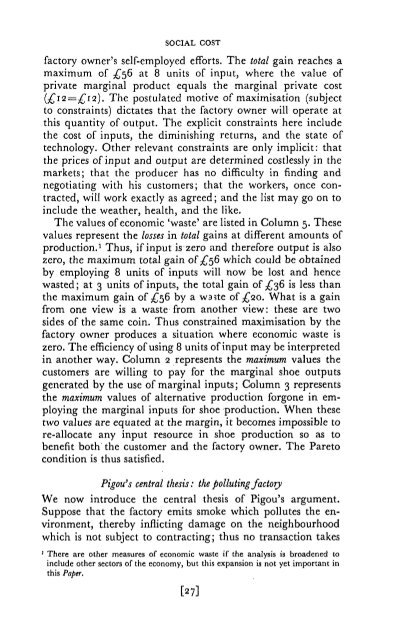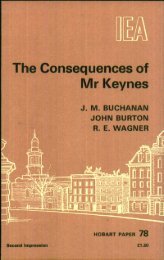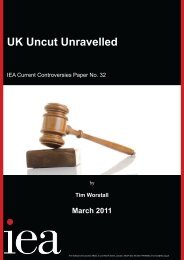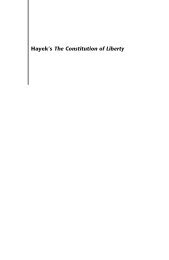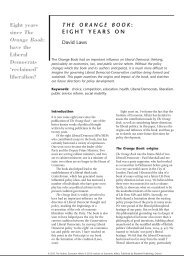THE MYTH OF SOCIAL COST.pdf - Institute of Economic Affairs
THE MYTH OF SOCIAL COST.pdf - Institute of Economic Affairs
THE MYTH OF SOCIAL COST.pdf - Institute of Economic Affairs
You also want an ePaper? Increase the reach of your titles
YUMPU automatically turns print PDFs into web optimized ePapers that Google loves.
<strong>SOCIAL</strong> <strong>COST</strong><br />
factory owner's self-employed efforts. The total gain reaches a<br />
maximum <strong>of</strong> £56 at 8 units <strong>of</strong> input, where the value <strong>of</strong><br />
private marginal product equals the marginal private cost<br />
(^12=^12). The postulated motive <strong>of</strong> maximisation (subject<br />
to constraints) dictates that the factory owner will operate at<br />
this quantity <strong>of</strong> output. The explicit constraints here include<br />
the cost <strong>of</strong> inputs, the diminishing returns, and the state <strong>of</strong><br />
technology. Other relevant constraints are only implicit: that<br />
the prices <strong>of</strong> input and output are determined costlessly in the<br />
markets; that the producer has no difficulty in finding and<br />
negotiating with his customers; that the workers, once contracted,<br />
will work exactly as agreed; and the list may go on to<br />
include the weather, health, and the like.<br />
The values <strong>of</strong> economic 'waste' are listed in Column 5. These<br />
values represent the losses in total gains at different amounts <strong>of</strong><br />
production. 1 Thus, if input is zero and therefore output is also<br />
zero, the maximum total gain <strong>of</strong> £56 which could be obtained<br />
by employing 8 units <strong>of</strong> inputs will now be lost and hence<br />
wasted; at 3 units <strong>of</strong> inputs, the total gain <strong>of</strong> £36 is less than<br />
the maximum gain <strong>of</strong> £56 by a waste <strong>of</strong> £20. What is a gain<br />
from one view is a waste from another view: these are two<br />
sides <strong>of</strong> the same coin. Thus constrained maximisation by the<br />
factory owner produces a situation where economic waste is<br />
zero. The efficiency <strong>of</strong> using 8 units <strong>of</strong> input may be interpreted<br />
in another way. Column 2 represents the maximum values the<br />
customers are willing to pay for the marginal shoe outputs<br />
generated by the use <strong>of</strong> marginal inputs; Column 3 represents<br />
the maximum values <strong>of</strong> alternative production forgone in employing<br />
the marginal inputs for shoe production. When these<br />
two values are equated at the margin, it becomes impossible to<br />
re-allocate any input resource in shoe production so as to<br />
benefit both the customer and the factory owner. The Pareto<br />
condition is thus satisfied.<br />
Pigou's central thesis: the polluting factory<br />
We now introduce the central thesis <strong>of</strong> Pigou's argument.<br />
Suppose that the factory emits smoke which pollutes the environment,<br />
thereby inflicting damage on the neighbourhood<br />
which is not subject to contracting; thus no transaction takes<br />
1 There are other measures <strong>of</strong> economic waste if the analysis is broadened to<br />
include other sectors <strong>of</strong> the economy, but this expansion is not yet important in<br />
this Paper.<br />
[27]


